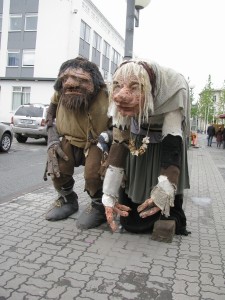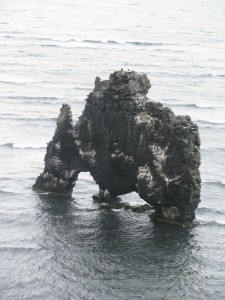The trolls. Posted by hulda on Jul 16, 2012 in Icelandic culture, Icelandic history
 Perhaps the most variable of all supernatural creatures of Iceland is tröll, a troll. Stories of them describe their size alone ranging from the size of a mountain to something resembling a very large human. Their behaviour varies likewise from friendly and loyal to solitary, hermit-like sages to beastly and violent man eaters. Sometimes trolls were said to turn into stone if daylight fell on them* but some well-known stories like Skessan á Arnarvatnsheiði (= The Giant Woman of Arnarvatnsheiði) have a troll, in this case a troll lady, that could move about freely any time of the day. They had many names: besides tröll they could be called f.ex. skessur, þursar, risar and even jötnar, although the common idea is that a jötunn is an entirely different being than a tröll**. When a human chanced to meet tröll in the wild*** it was likely they would not survive the encounter alive, unless of course they were so unbelievably lucky as to come across an agreeable one.
Perhaps the most variable of all supernatural creatures of Iceland is tröll, a troll. Stories of them describe their size alone ranging from the size of a mountain to something resembling a very large human. Their behaviour varies likewise from friendly and loyal to solitary, hermit-like sages to beastly and violent man eaters. Sometimes trolls were said to turn into stone if daylight fell on them* but some well-known stories like Skessan á Arnarvatnsheiði (= The Giant Woman of Arnarvatnsheiði) have a troll, in this case a troll lady, that could move about freely any time of the day. They had many names: besides tröll they could be called f.ex. skessur, þursar, risar and even jötnar, although the common idea is that a jötunn is an entirely different being than a tröll**. When a human chanced to meet tröll in the wild*** it was likely they would not survive the encounter alive, unless of course they were so unbelievably lucky as to come across an agreeable one.
There’s a logic to the wide range of different kinds of tröll, though. It’s got to do with the era that the story was first written down. The older the legend, the more dangerous the creature is, is a good rule of thumb. Going back to Skáldskaparmál in Prose Edda, the troll woman we see there introduces herself as “…storm-sun’s bale, seeress’s friendly companion, guardian of corpse-fiord, swallower of heaven-wheel…”
Yet, in today’s Icelandic culture trolls that were once capable of eating the very sun have somehow turned into quite likeable creatures. A group of them called Jólasveinar (= Yule Lads) even brings children presents at Christmas. It goes without saying that these “Christmas trolls” have not always been quite as friendly as they’re described to be now, though. In old times children were told stories of them stealing and breaking things in human houses to scare them into behaving well, and if all else failed there was always Grýla, their mother, who liked nothing better than a dinner made of small children. Her monstrous pet cat, Urðarköttur****, was even less picky: she ate everyone who didn’t receive a new item of clothing at Christmas!
Lóndrangar: a male troll who sat here dangling his feet when the sun came up.
If Christmas was a test of survival for children, the troll women posed an even worse threat for men throughout the year. Somewhat more common in stories than their male counterparts, it was especially the troll women who were known for eating humans, killing them for fun and in some cases raping and imprisoning young men they took a liking to. I’m not making this up – the male trolls seemed to pay human women very little attention***** but the skessur, or big women as one translation goes, were very fond of human males, especially in times when male trolls were scarce due to their constant warring. Not all of them were quite as horrible gaining themselves a human spouse, though. The troll woman in Skessan á Arnarvatnsheiði simply helped out two men that were lost, and when she had shown them the way home the other of them eventually returned back to live with her.
Today the image of tröll has gone through perhaps the biggest metamorphose ever. More than ever, people want to believe in the general goodwill of a creature that once was a bloodthirsty predator, giving rise to a large amount of new or re-written old stories. Brian Pilkington is especially skillful in his presentation of the Icelandic legends and quite accepted by our professor who taught us folk tales and -beliefs. In Pilkington’s works we see many different types of supernatural creatures that can all go under the name tröll and get a logical explanation to why even the ones that are from the same type are so different in behaviour. Other writers like Þórarinn Leifsson have also considered the logical outcome of those human-troll liaisons mentioned above, the halftrolls that can pass as humans so well that their origin does not ever really surface.
Hvítserkur, the white skirt. Two kinds of stories are told of this rock formation: either it’s a troll cow bending down to take a drink from the sea or a troll man who was so furious at the sound of church bells at Þingeyri that he planned to go tear down the whole church, only to have the dawn creep on him by surprise long before he reached his destination.
However, it’s still good to know and bear in mind what these creatures were known to be like once upon a time. The mountains look very nice this time of the year, don’t they? But you better watch out…
*These are usually called nátttröll (= night trolls), also spelled as náttröll and nátt-tröll. Iceland is full of famous nátttröll like the couple of examples I’ve photographed but you can probably find some smaller ones yourself if you go on a hiking tour!
**All of these names of trolls go with slightly different, yet similar creatures, very much like how álfar and huldufólk are similar but not exactly synonymous.
***Trolls live on the mountains and tend to be solitary. Sometimes a few trolls can live together but usually only if they’re of the same family.
****My big Icelandic-Icelandic dictionary knows to tell me that urðarköttur is “köttur sem hefur lifað á dauðum mansskrokkum í þrjá vetur… …drepur með augnatilliti sínu einu saman.” Translated that would mean that a cat that feeds on dead human bodies for three winters turns into an urðarköttur, which is such a powerful monster it can kill people with a glance. You don’t even need to lock eyes with it, if it sees you you’re as good as dead. Little details such as these really tell you it’s a story for children. 😀
*****There’s only one troll story among the ones I’ve read so far in which a male troll tries to put up his charms at a human girl but alas, he fails because the girl is too good for him, or so she herself claims to be. In the end she tells the troll to %*#&”% off and go turn into a stone, which he then immediately does. Goes to show that rejection hurts even if you’re a troll.

Build vocabulary, practice pronunciation, and more with Transparent Language Online. Available anytime, anywhere, on any device.
About the Author: hulda
Hi, I'm Hulda, originally Finnish but now living in the suburbs of Reykjavík. I'm here to help you in any way I can if you're considering learning Icelandic. Nice to meet you!






Comments:
Geena:
Hi Hulda,
My name is Geena and I am planning a trip to Iceland for a few days in the beginning of September. I am very interested in subjects relating to fairytales and the supernatural, and wanted to know where I could learn more about Iceland’s folklore on trolls and elves, etc. I know there is the Trolls/Elves/Ghost Museum in Stokkseyri, but I think they might be closed by the time we will be visiting (I sent them an email to find out). But besides there, do you know of any other museums/sights/tours/resources?
Thank you so much, and I really enjoyed your article!
Geena
hulda:
@Geena You’re probably right about the museum, it seems to be open only for groups and only by request during the off-season… there is however the Elf School that might be interesting, you can read more about the place, their pricing and timetables here:
http://www.elfmuseum.com/home
Another thing I can recommend are the book stores and especially the troll and elf book series’ by Brian Pilkington. They’re beautifully illustrated, tell many of the central Icelandic myths about the hidden people, in short they’re entirely worth their price (I own a few).